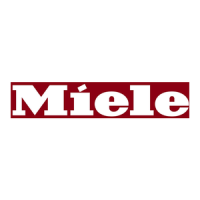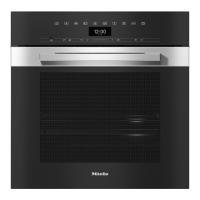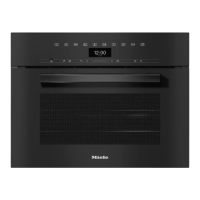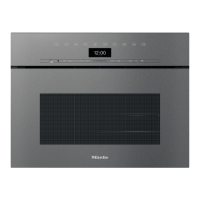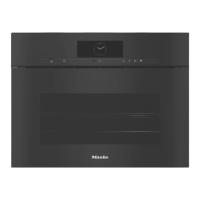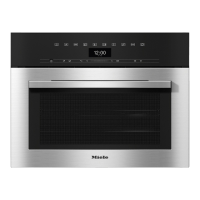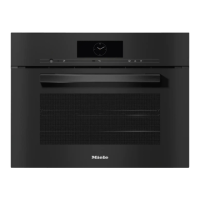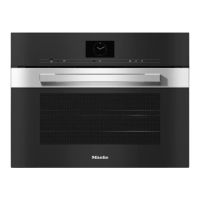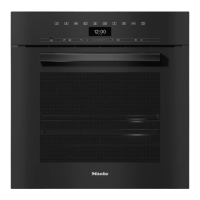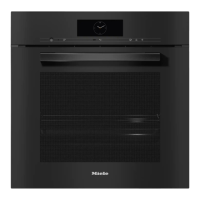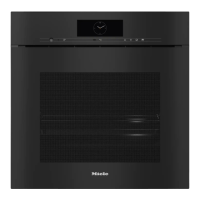Do you have a question about the Miele DGC 7250 and is the answer not in the manual?
Provides safety guidelines and precautions related to children's interaction with the appliance.
Covers safety aspects related to installation, maintenance, and electrical connections.
Details the functions of various sensors located below the main display.
Process of filling the water container for steam cooking.
Outlines safety features like system lock, sensor lock, and cooling fan.
Covers standard settings, language, location, Miele@home, time, and water hardness.
Procedure for the initial heating cycle and rinsing the steam system.
Lists all available settings and their options.
Covers Safety Locks, Miele@home, and Remote Control.
Detailed table and explanation for setting water hardness levels.
Detailed options for Miele@home activation, status, and reset.
Explains how to use the minute minder for timing activities.
Step-by-step guide to setting a duration for the minute minder.
Tips on efficient programme selection and usage for energy saving.
Procedure for drying the oven after steam cooking.
Adjusting temperature, duration, finish, or start times during cooking.
Guide to permanently adjusting the recommended cooking temperature.
Instructions for setting cooking duration, finish time, or start time.
How to stop a cooking programme and reset all set durations.
Steps to pause and resume steam cooking programmes.
Explains the basic principles of cooking with steam only.
Lists suitable foods and seasoning tips.
Explains the function combining heating and steam injection.
Lists suitable foods and steam injection timing.
Details on manual and automatic steam burst injection.
Step-by-step guide to selecting and using automatic programmes.
Instructions for gentle defrosting while retaining vitamins and minerals.
Ideal method for cooking delicate meat cuts to achieve tenderness.
Instructions and safety for preserving fruit and vegetables in jars.
Method for preserving fruit, vegetables, and herbs by drying.
Tips for cooking frozen foods like pizzas, chips, and ready meals.
General advice for baking and when to use baking paper.
General advice for roasting meat and poultry, including dish types and liquid.
Functions suitable for roasting, including steam assistance and energy saving.
Usage of Full Grill and Fan Grill functions.
Detailed usage instructions for the Fan Grill function.
Table of foods with grilling temperature, shelf level, and duration.
List of cleaning agents and tools to avoid to prevent damage.
Steps for cleaning everyday soiling using recommended methods.
Methods for tackling tough stains on most oven surfaces.
Guidance on using specific oven cleaners, including application and precautions.
Procedure for removing oil and grease, including catalytic cleaning.
Explanation of the process for evaporating moisture after steam use.
Steps to initiate the residual moisture evaporation process.
Information on descaling frequency and prompts.
Steps and materials needed for descaling preparation.
Detailed instructions for initiating and performing the descaling process.
How to rinse the steam injection system after descaling.
Process of evaporating moisture and drying after rinsing.
Troubleshooting a dark display, no signal tone, or no power.
Troubleshooting oven not heating and system lock activation.
How to contact Miele customer service for unresolved issues.
Provides precise dimensions for cabinet installation.
Crucial information on electrical connections and ventilation.
Step-by-step instructions for physical installation.
Detailed requirements and safety for electrical hookup.
Provides safety guidelines and precautions related to children's interaction with the appliance.
Covers safety aspects related to installation, maintenance, and electrical connections.
Details the functions of various sensors located below the main display.
Process of filling the water container for steam cooking.
Outlines safety features like system lock, sensor lock, and cooling fan.
Covers standard settings, language, location, Miele@home, time, and water hardness.
Procedure for the initial heating cycle and rinsing the steam system.
Lists all available settings and their options.
Covers Safety Locks, Miele@home, and Remote Control.
Detailed table and explanation for setting water hardness levels.
Detailed options for Miele@home activation, status, and reset.
Explains how to use the minute minder for timing activities.
Step-by-step guide to setting a duration for the minute minder.
Tips on efficient programme selection and usage for energy saving.
Procedure for drying the oven after steam cooking.
Adjusting temperature, duration, finish, or start times during cooking.
Guide to permanently adjusting the recommended cooking temperature.
Instructions for setting cooking duration, finish time, or start time.
How to stop a cooking programme and reset all set durations.
Steps to pause and resume steam cooking programmes.
Explains the basic principles of cooking with steam only.
Lists suitable foods and seasoning tips.
Explains the function combining heating and steam injection.
Lists suitable foods and steam injection timing.
Details on manual and automatic steam burst injection.
Step-by-step guide to selecting and using automatic programmes.
Instructions for gentle defrosting while retaining vitamins and minerals.
Ideal method for cooking delicate meat cuts to achieve tenderness.
Instructions and safety for preserving fruit and vegetables in jars.
Method for preserving fruit, vegetables, and herbs by drying.
Tips for cooking frozen foods like pizzas, chips, and ready meals.
General advice for baking and when to use baking paper.
General advice for roasting meat and poultry, including dish types and liquid.
Functions suitable for roasting, including steam assistance and energy saving.
Usage of Full Grill and Fan Grill functions.
Detailed usage instructions for the Fan Grill function.
Table of foods with grilling temperature, shelf level, and duration.
List of cleaning agents and tools to avoid to prevent damage.
Steps for cleaning everyday soiling using recommended methods.
Methods for tackling tough stains on most oven surfaces.
Guidance on using specific oven cleaners, including application and precautions.
Procedure for removing oil and grease, including catalytic cleaning.
Explanation of the process for evaporating moisture after steam use.
Steps to initiate the residual moisture evaporation process.
Information on descaling frequency and prompts.
Steps and materials needed for descaling preparation.
Detailed instructions for initiating and performing the descaling process.
How to rinse the steam injection system after descaling.
Process of evaporating moisture and drying after rinsing.
Troubleshooting a dark display, no signal tone, or no power.
Troubleshooting oven not heating and system lock activation.
How to contact Miele customer service for unresolved issues.
Provides precise dimensions for cabinet installation.
Crucial information on electrical connections and ventilation.
Step-by-step instructions for physical installation.
Detailed requirements and safety for electrical hookup.
| Oven size | Large |
|---|---|
| Oven type | Electric |
| Bottom heating | Yes |
| Number of ovens | 1 |
| Total oven power | 3500 W |
| Convection cooking | No |
| Full surface grill | - |
| Oven thermostat range | 30 - 250 °C |
| Number of shelf positions | 5 |
| Total oven(s) interior capacity | 76 L |
| Maximum temperature (conventional) | 100 °C |
| Lamp type | Halogen |
| Door hinge | down |
| Control type | Buttons |
| Door material | Glass |
| Product color | Black |
| Lamps quantity | 1 lamp(s) |
| Control position | Top front |
| Interior material | Enamel |
| Oven door opening | Drop down opening |
| Appliance placement | Built-in |
| Water tank capacity | 1 L |
| Clock type | Electronic |
| Timer modes | Cooking time, End cooking time |
| Current | 16 A |
| AC input voltage | 220 - 240 V |
| AC input frequency | 50 Hz |
| Energy efficiency scale | A+++ to G |
| Energy consumption (conventional) | 1.05 kWh |
| Energy consumption (forced convection) | 0.71 kWh |
| Depth | 568 mm |
|---|---|
| Width | 595 mm |
| Height | 596 mm |
| Weight | 42000 g |
| Installation compartment depth | 550 mm |
| Installation compartment width (min) | 560 mm |
| Installation compartment height (min) | 590 mm |
